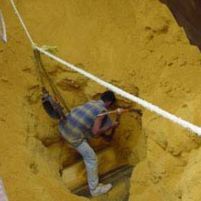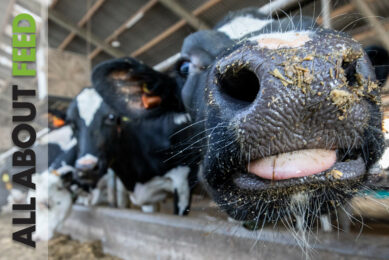Flowability problems of DDGS

Dried distillers’grains with solubles (DDGS) can have some undesirable handling characteristics related to poor flowability under certain conditions. Reduced flowability and bridging of DDGS in bulk storage containers and transport trucks hampers their in feeding livestock.
So far the flow characteristics of DDGS have
marginally been researched. In other products routinely flow enhancing product
are added, such as for example calcium carbonate in soybean meal.
Research
Research by the Swine research Group at the University of
Minnesota, lead by Lee Johnston, professor and swine Extension specialist,
designed a study to determine if the addition of selected flowability agents is
effective in improving flowability of DDGS in practical commercial conditions.
The study was conducted at the BushMills Ethanol plant in Atwater,
Minnesota. Four treatments were examined: a control that received no flowability
agent; 5 pounds (2.25 kg) per ton of DMX-7 (Delst, Inc.); 2% calcium
carbonate (ILC
Resources); or 1.25% clinoptilolite zeolite (St.
Cloud Mining).
Each of these flowability agents were mixed into lots
of DDGS with either 9% or 12% moisture, resulting in a total of eight
treatments.
Once the lots of DDGS were prepared, each one was loaded into a
separate compartment of a commercial feed truck. The truck travelled about 250
km, sat idle for two days, and then travelled 250 km back to the ethanol plant.
Upon returning to the ethanol plant, the time required to unload each
compartment of the truck was
recorded.
Conclusions
From these recordings it was
found that drying DDGS to 9% moisture greatly improved flowability compared to
12% (620 kg/minute vs. 390 kg/min). None of the flowability agents improved the
flow rate of the DDGS.
Johnston concludes that moisture level of DDGS plays a
very important role in determining the flowability of the final product.
Addition of the flowability agents at the levels they studied provided little
evidence for improved flowability of DDGS.
An additional aspect of the study
yet to be completed is to determine characteristics of DDGS that might predict
poor flow rates before they create problems in commercial systems.
“By
evaluating and determining the main factors involved with flowability of DDGS,
we hope to be able to explain differences in flowability observed from different
DDGS sources, and aid ethanol plants in improving the handling characteristics
of DDGS produced,” Johnston said.
Related link:
Dossier AllABout Bio Energy
To subscribe to the
free AllAboutFeed newsletter click here.











